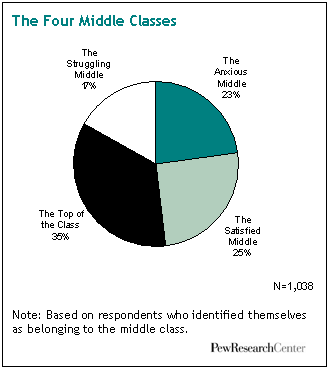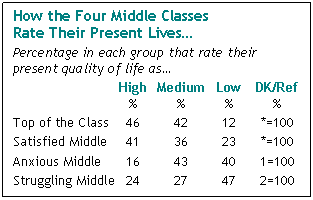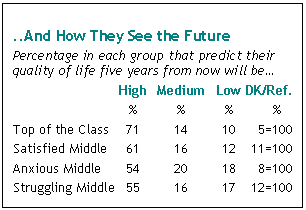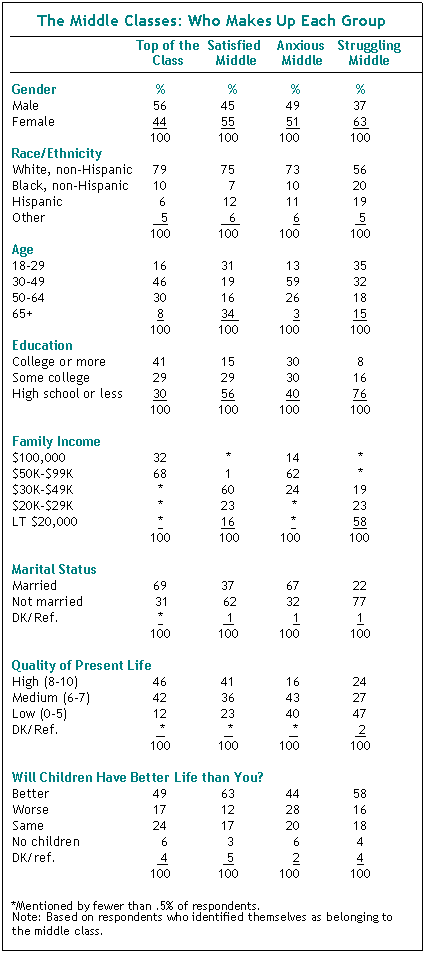I. Overview
There isn’t one American middle class; there are four. Each is different from the others in its attitudes, outlook and financial circumstance—sometimes in ways that defy traditional stereotypes of the middle class, according to an analysis of a recent national survey conducted by the Pew Research Center Social and Demographic Trends project.
 One middle class is doing quite well, thank you. And members of this group—predominantly male, disproportionately well-educated and financially secure—expect to do even better in the future. It’s the largest of the four groups, comprising slightly more than a third of the 53% of Americans who identify themselves as “middle class” in the Pew Research survey. Call them The Top of the Class.
One middle class is doing quite well, thank you. And members of this group—predominantly male, disproportionately well-educated and financially secure—expect to do even better in the future. It’s the largest of the four groups, comprising slightly more than a third of the 53% of Americans who identify themselves as “middle class” in the Pew Research survey. Call them The Top of the Class.
Life is considerably tougher for The Struggling Middle, a group disproportionately composed of women and minorities. In fact, many members of the Struggling Middle have more in common with the lower class1 than they do with those in the other three groups and actually have a lower median family income than Americans who put themselves on the lowest rungs of the social ladder. About one-in-six self-identified middle class Americans fall into the Struggling Middle.
The Satisfied Middle has everything but money; their comparatively modest incomes have not muted their sunny outlooks or overall satisfaction with their lives. This group is disproportionately old and disproportionately young; middle aged adults are relatively scarce in the Satisfied Middle. They make up a quarter of the middle class.
By the conventional yardsticks of income, education, age, employment and family status, the fourth middle class group is the most middle class of all—and the most dissatisfied and downbeat of the four groups. While they enjoy some of the economic advantages of the Top of the Class, they express many of the same bleak judgments about their lives as those in the Struggling Middle. Call them The Anxious Middle; they make up slightly less than a quarter of all middle class Americans.

These four groups are all part of the 53% majority of Americans who identified themselves as “middle class” in a Pew Research telephone survey taken from Jan 24 through Feb. 19, 2008 among a nationally representative sample of 2,413 adults. The groups were revealed by a statistical technique known as cluster analysis that searched for patterns in the way these self-identified middle class Americans answered key survey questions.
Two of the groups that emerged from this analysis—The Satisfied Middle and Anxious Middle—straddle the statistical middle of the American life. But the Top of the Class and Struggling Middle seem, in some ways, anything but middle class. Why don’t those in the Struggling Middle identify with the Lower Class; after all, their median family incomes fall well below the earnings of those Americans who say they’re in the least advantaged social class? And why don’t those seemingly privileged members of the Top of the Class identify with the Upper Class, with whom they seem to share so many advantages?
Part of the explanation likely lies with the powerful attraction that the label “middle class” has on most Americans and the stigma that some might associate either with the upper or lower class labels. But the analysis suggests that’s not all of the answer. On many key measures, the Top of the Class is different from the 21% of Americans who identify themselves as upper class in the Pew Research survey. For one thing, they don’t make as much money: The median income of those in the Top of the Class is $86,280, while median income for the upper class is $95,875, or more than $30,000 above the overall middle class median. And in terms of levels of education, total wealth and how they rate their lives, the Top of the Class lags behind those in the upper class.
 Similarly, those in the Struggling Middle are, as a group, demonstrably different from those who identify with the lower class. They’re significantly more likely to be female, to be young and to be single. But more importantly, they are more satisfied with their lives and more likely to say they’re living better than their parents. Also, they are more hopeful about their own futures and, in particular, the future of their children. A 40% plurality of the Struggling Middle say they expect their children’s lives will be “much better” than theirs are, compared with 25% of those who identify with the lower class. For these middle class Americans, at least for now, the American Dream may be more a dream than a reality—testimony that “middle class” is as much a state of mind as it is a financial condition.
Similarly, those in the Struggling Middle are, as a group, demonstrably different from those who identify with the lower class. They’re significantly more likely to be female, to be young and to be single. But more importantly, they are more satisfied with their lives and more likely to say they’re living better than their parents. Also, they are more hopeful about their own futures and, in particular, the future of their children. A 40% plurality of the Struggling Middle say they expect their children’s lives will be “much better” than theirs are, compared with 25% of those who identify with the lower class. For these middle class Americans, at least for now, the American Dream may be more a dream than a reality—testimony that “middle class” is as much a state of mind as it is a financial condition.
Taken together, this statistical typology of the four middle classes paints a nuanced picture of the American middle class and those who claim membership in it. Rather than being demographically and culturally monotonic, America’s middle class is an amalgam of distinct groups that share different outlooks on life and life experiences, a blend of young and old, black, white and Latino, optimists and pessimists, achievers and dreamers, those who are barely hanging on to the Middle Class Dream and those who are living it fully.
What follows is a statistical portrait of the four faces of the American middle class.



